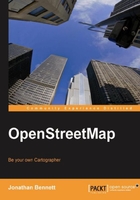
This book will allow you to take control of your own maps and use them smoothly. This book introduces the reader to the OpenStreetMap project and shows you how to participate in the project, and make use of the data it provides. No prior knowledge of the project is assumed, and technical details are kept to a minimum.
Chapter 1, Making a Free, Editable Map of the World explains how and why the project was started, how freely redistributable geographic data is different from maps that are merely free of charge to use, and some of the things the project has already achieved.
Chapter 2, Getting Started at openstreetmap.org covers the main features of openstreetmap.org and how to create and personalize an account on it. It explains how to use the documentation in the OpenStreetMap wiki, and how to communicate with the OpenStreetMap community.
Chapter 3, Gathering Data using GPS looks at the tools and techniques used by the OpenStreetMap community to gather data using GPS and upload it to the website. It also explains some basic surveying techniques.
Chapter 4, How OpenStreetMap Records Geographical Features covers the types of data you can record, such as nodes, ways, and relations. It also looks at the tagging system and how the community uses and manages it.
Chapter 5, OpenStreetMap's Editing Applications looks at the basic operation of OpenStreetMap's three most popular editors, including Potlatch, JOSM, and Merkaartor.
Chapter 6, Mapping and Editing Techniques explains how to draw features based on GPS traces, how to tag them, and how to find tags that mappers have used, but not documented.
Chapter 7, Checking OpenStreetMap Data for Problems explains how to find the cause of any problems you're having with OpenStreetMap data using the data inspection tools on openstreetmap.org, the NoName layer, ITOWorld OSM Mapper, and Geofabrik's OSM Inspector.
Chapter 8, Producing Customised Maps explains how to create maps using the standard renderings on openstreetmap.org, using a standalone rendering application for Windows and Kosmos, and in Scalable Vector Graphics (SVG) format using Osmarender.
Chapter 9, Getting Raw OpenStreetMap Data discusses ways of accessing the data in the OpenStreetMap database, such as Planet files, the main OpenStreetMap API, and the Extended API (XAPI).
Chapter 10, Manipulating OpenStreetMap Data using Osmosis looks at a tool that is used heavily within OpenStreetMap to manipulate data from planet files or extracts, or databases containing OpenStreetMap data, called Osmosis.
Chapter 11, OpenStreetMap's Future explains some of the changes being developed by the coders and mappers working on OSM, and how they'll affect users of the data.